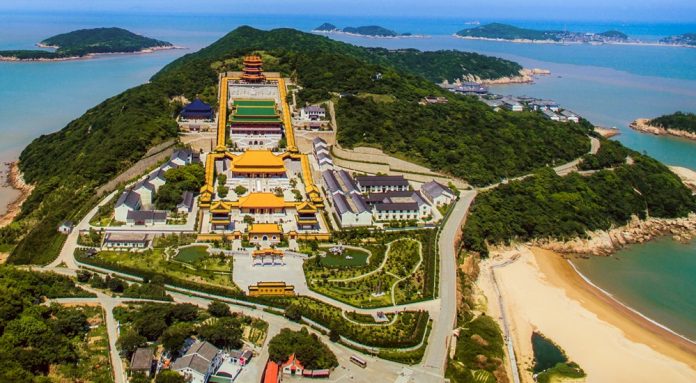Study by IFTM scholar concludes monastery members in popular Chinese Buddhist site view visitor control as part of religious duties
Research Corner | A partnership between Macau Business and the Macao Institute for Tourism Studies (IFT)

The visitor management system adopted by monasteries and nunneries at Pu-Tuo-Shan in Zhejiang province, mainland China – one of the four Sacred Mountains of Chinese Buddhism – has proven to work “quite well” over time, despite it looking “amateurish.” That is according to a new study by a scholar from the Macao Institute for Tourism Studies (IFTM). The system is based on monks and nuns playing the role of wardens.
The visitor control system relies on “the central and – compared to sacred sites of other religions – unusual role the resident members of its monasteries and nunneries play as hands-on custodians of their sacred space,” stated IFT scholar Cora Wong Un In in a research paper. “It appears that, by and large, they make sense of this role in a Buddhist spirit and perform it without taking leave” of the principles of their monastic training,” she noted.
The comments were featured in the research paper “Social interaction in visitor control at a Chinese Buddhist monastic site.” It was published earlier this year in the scholarly journal Tourism Recreation Research.
The main objective of Dr. Wong’s study was to look into the effects on monks and nuns at Pu-Tuo-Shan of often having to “interrupt their daily religious routine to act as wardens and inevitably interact with the public,” which she described as “a most un-monastic situation.”
Dr. Wong’s findings suggested that, “by and large the monastic members do not consider the time they spend as wardens as ‘time out’ from their Buddhist monastic life but as part of it.” According to her, monks and nuns “tolerate or even welcome the constant presence of many visitors” from the laity. This is because such visits give participating members of the public “a chance to become better acquainted with Buddhism.” The monks and nuns “view this hospitable stance as a Buddhist duty for themselves and a natural role for a monastery.”
The study results were based on individual interviews with 20 representatives of monastic orders at Pu-Tuo-Shan, namely people who had experience acting as wardens. For her research, Dr. Wong was given permission by the heads of a number of monasteries at Pu-Tuo-Shan to speak freely, on a one-to-one basis, with any monk or nun on warden duty that she wished to approach.
“It was striking that the informants almost always formulated their comments in the context of Buddhism, rarely expressing themselves from the mundane perspective of a mere warden when talking about themselves in that role,” she wrote.

Religious tourism in China
Pu-Tuo-Shan is a major Chinese Buddhist pilgrimage site in China, with more than 1,100 years of history. It is located on a small island off the coast of Zhejiang province. A total of 28 monasteries, nunneries and shrines are scattered around the island, according to Dr. Wong’s study. These venues receive thousands of visitors each day, with the crowds swelling during religious festivals.
“The larger monasteries that attract the most visitors consist of a number of halls (temples), other monastic buildings, park areas and courtyards,” wrote Dr. Wong. “Unless used by the monks and nuns for devotion, the halls’ doors are open to the public.”
Pu-Tuo-Shan welcomes more than seven million visitors per year, almost all originating from elsewhere in Mainland China, according to the IFTM scholar. “Only a very small minority of the visitors are pilgrims who are lodged in the monasteries, participate [in] devotions and take their meals with the monastic members,” noted Dr. Wong. “Most visitors are day visitors with a whole range of motivations, interests, and behaviours, and who spend only a few hours” on the grounds of the monasteries.
The IFTM scholar wrote in her paper that religious sites in China were “important assets” in the development of the country’s tourism sector. A boom in religious tourism had been taking place over the past 30 years, Dr. Wong said. It had led to a need to introduce visitor-control measures at a number of sites. In the case of Pu-Tuo-Shan, that responsibility had been assigned to the members of the monastic orders there, she added.
“On duty, the monastic members are partly wardens, partly religious mentors and partly knowledgeable on-site guides,” wrote Dr. Wong. “Compared to the traditional forms of monastic work such as agriculture or… crafts, the occupation of warden requires much more contact with the secular society and as such is more remote from the monastic ideal. The monastic members as wardens are engaged, to an extent, in ‘public relations’ work, which sits uncomfortably with monastic life,” she suggested.
Dr. Wong said the monastic-warden approach helped reduce the operational costs of monasteries, by avoiding the expense of employing guards from the secular community. Another advantage of this model was that – due to their religious position – monks and nuns could be seen has having “more authority in the eyes of the lay public than menial lay guards would have.”
Dr. Wong pointed out in her study that there was a “quasi-absence of visiting rules” at Pu-Tuo-Shan. “The latitude that the system allows the wardens, in a sense also respects their own free will,” she noted, adding that this chimed with fundamental Buddhist concepts. Dr. Wong added that, according to her experience – which encompassed 12 visits to Pu-Tuo-Shan over the course of eight years – the system had worked “quite well over the years.” The atmosphere at the Pu-Tuo-Shan monastic sites was “serene in spite of the crowding, without any apparent containment or herding of visitors.”

– The researcher
Cora Wong Un In is an assistant professor at the Macao Institute for Tourism Studies (IFTM). She holds a PhD from the University of Waikato, in New Zealand. Dr. Wong first started her higher education at IFTM, where she gained a bachelor’s degree in Tourism Business Management. Her research interests include pilgrimages and religious tourism, cultural heritage interpretation, post-colonialism, tourist travel experience, and tourism impact and visitor management. She is a member of the IFT team delivering cultural heritage specialist guide training as part of the UNESCO World Heritage Guide Training Programme in Asia.
– The paper
Cora Un In Wong: “Social interaction in visitor control at a Chinese Buddhist monastic site”, Tourism Recreation Research, Volume 44, Issue 1, pages 66-75, 2019.






























